Table of Contents
Toxins in Mattresses: Is Your Bed Making You Sick?
This page may contain affiliate links. We may earn a commission on purchases, at no additional cost to you. Learn more →
Have you ever woken up feeling groggy, congested, or just not well-rested—despite getting a full night’s sleep? What if your mattress, the very thing meant to provide comfort and support, is actually working against you?
We spend abouta third of your life in bed—roughly 20 to 26 years! But while we obsess over clean eating and exercise, we rarely stop to think about what we’re inhaling and absorbing while we sleep. Toxins in mattresses can off-gas right where you rest your head, potentially causing a range of short- and long-term health issues.
Did you know that most conventional mattresses are crafted from synthetic foams, PVC and volatile organic compounds (VOCs), and chemical flame retardants - all of which pose significant health risks?
In this article, we'll look into the common toxic chemicals found in mattresses, how they can impact your health, and what you can do to create a cleaner, non-toxic living and sleeping space.
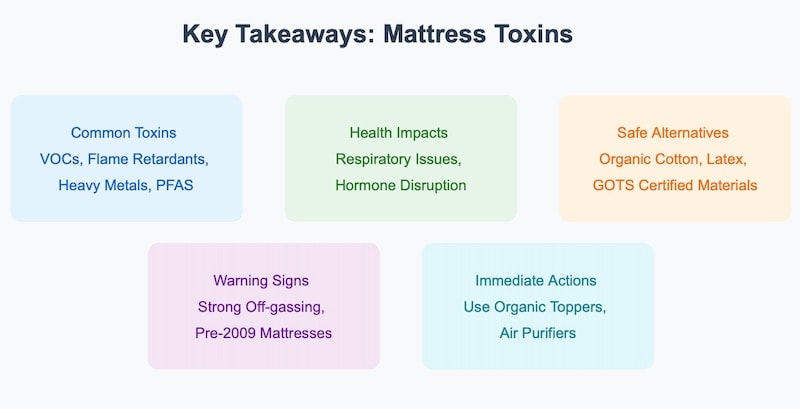
Toxins in Mattresses: 6 Hidden Chemicals Impacting Your Health
Some of the common culprits, that may be making your mattresses toxic include...
Volatile Organic Compounds (VOCs): The Silent Off-Gassing Threat
Most conventional mattresses, especially those made with polyurethane (PU) foam or memory foam, can off-gas volatile organic compounds (VOCs). These are introduced during manufacturing and may release into your bedroom for weeks or months after unpacking. Although the strongest off-gassing usually subsides within the first few days, low-level emissions can persist longer.
Common VOCs in synthetic foams include:
-
Propylene oxide: A potential neurotoxin and irritant
-
Toluene diisocyanate (TDI): A respiratory irritant that can cause asthma-like symptoms
-
Benzene: A known carcinogen
-
Formaldehyde: A cancer-linked adhesive and fabric treatment found in some mattresses
The VOCs that are introduced during the manufacturing process are then released into your bedroom, sometimes for years, so knowing how to remove VOCs is crucial!
Off-Gassing Warning: Short-term exposure to concentrated VOCs can lead to headaches, dizziness, and respiratory irritation. For sensitive individuals—like those with asthma or multiple chemical sensitivity—these irritations can be more severe.
➡ Solution: Choose a low-VOC certified mattress (CertiPUR-US, GOTS, or GOLS certified) and allow your mattress to off-gas in a well-ventilated room for 48–72 hours before sleeping on it
Chemical Flame Retardants: A Hidden Hormone Disruptor
To meet fire safety regulations, many mattress manufacturers add chemical flame retardants, but at a cost to your health. Until 2009, most mattresses contained PBDEs (polybrominated diphenyl ethers)—now banned due to links to hormone disruption, cancer risk, and lower IQ in children.
However, PBDEs have been replaced with newer organophosphate-based flame retardants, which can still affect the endocrine system (EWG Report).
Other flame retardants to watch for:
• Organophosphate-based flame retardants (linked to endocrine disruption).
• Fiberglass as a flame barrier (can cause skin and respiratory irritation if fibers escape), EPA warns about long-term exposure.
• Antimony (Found in 23% of tested mattresses) or boric acid in batting layers (both have potential toxicity if frequently inhaled or ingested)
If your mattress is 10+ years old, be aware it might contain banned PBDEs. Modern mattresses may replace PBDEs with other flame-retardant chemicals or materials—some safer than others. I.e. modern mattresses use fibreglass as a fire barrier, which can lead to rashes and respiratory irritation.
➡ Solution: Look for mattresses with natural fire barriers, like wool or silica-treated rayon, instead of chemical-based flame retardants.
Heavy metals: Yes, They Might Be in Your Bed
High-quality foam and fabric shouldn’t contain heavy metals—especially if they carry CertiPUR-US or OEKO-TEX certifications. Yet, certain older or lower-quality mattresses may have dyes and additives containing metals like antimony, mercury, or lead. Over time, exposure to these metals can lead to neurological issues or developmental delays in children.
➡ Solution: Stick to OEKO-TEX or CertiPUR-US certified mattresses, which are tested for heavy metals (CertiPUR-US FAQ).
Per- and Polyflouroalkyl Substances (PFAS): The Stain-Resistant Toxins
PFAS, sometimes called “forever chemicals,” are used for stain-resistant or water resistance properties. If your mattress claims to repel liquids or resist stains, there’s a good chance it contains PFAS.
These chemicals:
• Do not break down in the environment (or in the body).
• Have been linked to hormonal imbalances, immune suppression, and certain cancers.
In response to growing health concerns, some U.S. states have begun banning PFAS in bedding and juvenile products.
➡ Solution: Avoid mattresses labeled as “stain-resistant” or “waterproof” unless they explicitly state PFAS-free(California AB 1817).
Phthalates: The Hidden Plasticiser in Your Bed
You've probably heard of phthalates in relation to plastics, but did you know they are commonly found in waterproof mattress covers and synthetic components? They’re known endocrine disruptors that can interfere with hormone function, potentially affecting fertility and increasing risk of reproductive issues.
• If a mattress label mentions “vinyl,” “PVC,” or “odor control,” it could be a red flag indicating the presence of phthalates or undisclosed chemicals.
• Some children’s products are phthalate-free by law, but adult mattresses may still include them unless otherwise stated.
Phtalates often hide under the term "fragrance" on labels, so it you see a mattress advertising "odor control", its a red flag!
➡ Solution: Opt for natural materials like organic cotton, wool, or natural latex instead of synthetic vinyl covers.
Pesticides & Fungicides: A Dirty Secret in Cotton Mattresses
Not all cotton mattresses are created equal. Non-organic cotton is one of the most heavily pesticide-treated crops, meaning mattresses and mattress covers may contain pesticides, fungicides and herbicides left over from the growing process - used to prevent pest infestations and mild growth.
Residues can linger in cotton batting or fabric, causing skin irritation or allergic reactions—and with prolonged exposure, potentially more severe health outcomes, like neurotoxicity and increased risks of cancers.
➡ Solution: Choose GOTS-certified organic cotton, which is grown without synthetic pesticides.
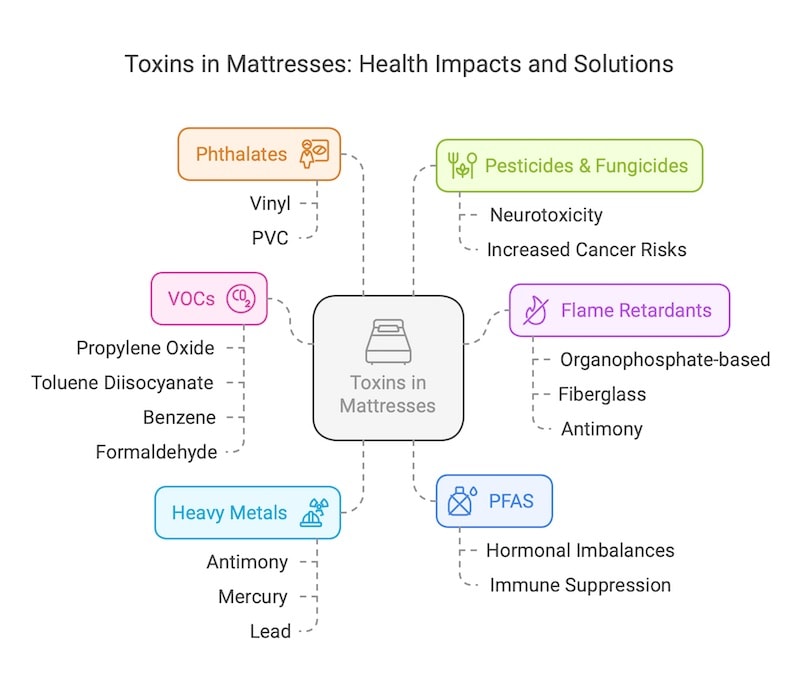
Can a Mattress Affect Your Health?
Absolutely! Over time, the chemicals in your mattress can migrate from the bed into the air and dust in your bedroom, which you inhale night after night. Depending on your sensitivity and the types of chemicals present, you may face:
Short Term Health Concerns:
-
Respiratory Issues: VOCs and certain flame retardants can trigger respiratory problems like asthma and allergy flare-ups.
-
Allergic Reactions & Skin Sensitivities: Chemical finishes on fabrics can cause rashes or itching, especially in individuals prone to contact dermatitis.
Longer-term Health Risks
-
Hormonal Disruption - Flame retardants (like PBDEs) and synthetic chemicals used in mattresses can interfere with the endocrine system, potentially leading to hormonal imbalances, and even impacting fertility and
-
Cancer and immune system suppression - Prolonged exposure to flame retardants and certain VOCs (like formaldehyde) has been linked to increased cancer risk and reduced immune function.
How do I know if my Mattress is Toxic?
Ever wake up feeling groggy or battling unexplained headaches? It might not just be your sleep schedule—it could be your mattress. While not all synthetic materials are equally hazardous, certain signs can indicate a toxic mattress:
-
Strong Chemical Smell (Off-Gassing): If that “new mattress smell” lingers for weeks, you’re likely breathing harmful VOCs.
-
Frequent Headaches, Allergies, or Respiratory Issues: Notice these symptoms worsen at night or upon waking? Your mattress could be releasing irritants.
-
Older Mattresses (10+ Years): Mattresses made before PBDE bans (around 2009 in the U.S.) may contain these now-banned flame retardants. Wear-and-tear can also release more foam dust over time.
-
Label Red Flags: Look for terms like “polyurethane foam,” “vinyl cover,” or “flame retardant chemicals.”Absence of third-party certifications may also be a red flag.
Note, that brands that offer "budget-friendly" and "luxury memory foam" mattresses often rely on synthetic materials! These materials are more likely to "off-gas" into your sleeping environment.
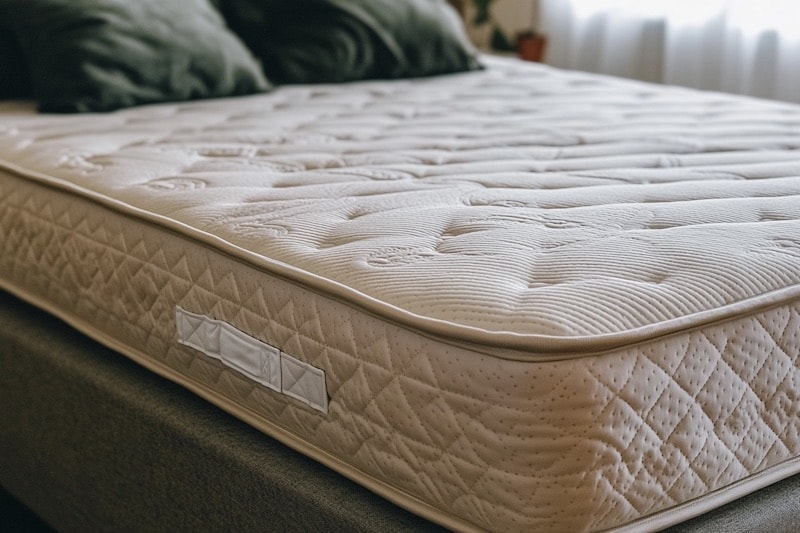
The Best Non-Toxic Mattress Alternatives
Organic & Natural Materials:
-
Organic Natural Latex Mattresses - made from natural rubber, are breathable and completely free from VOCs.
However, be cautious of synthetic latex, which is marketed as 'eco-friendly' but still contain VOCs. If choosing latex look for GOLS-certified latex
Brands like Naturepedic and Avocado Green offer the best organic mattresses with GOLS-certified organic latex!
-
Organic cotton and Wool Mattresses - Naturally flame-resistant, moisture wicking, and free from synthetic chemicals! This is a great choice for sensitive sleepers
Pro Tip: If you're looking for a safer mattress, avoid anything labeled "memory foam" unless its CertiPUR-US certified and verified to be free or VOCs and formaldehyde
Certifications to Look For:
Not all organic claims are legit, so check for third-party sustainability certifications that verify a mattress is truly non-toxic:
-
GOTS (Global Organic Textile Standard) - ensures cotton and wool are certified organic and free from harmful chemicals
-
GOLS (Global Organic Latex Standard) - Guarantees that latex is at least 95% organic; Bans 350+ chemicals, but allows 5% synthetics
-
OEKO-TEX - Tests for harmful substances in textiles and foams
-
CertiPUR-US - Verifies that foam-based mattresses are free from formaldehyde, heavy metals and ozone depleters. Doesn’t test for PFAS/flame retardant
Pro Tip: Combine certifications (e.g., GOTS + GREENGUARD Gold) for comprehensive protection!
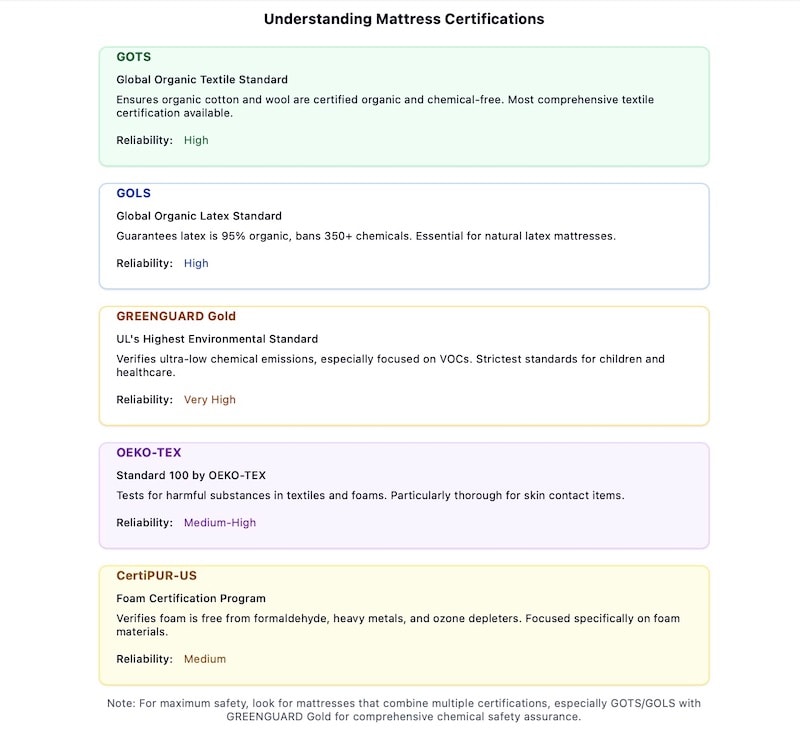
What Can You Do? Steps to Reduce Your Exposure
If tossing out your mattress isn't an option, do not worry! There are plenty or practical steps you can take right now to reduce your exposure and create a healthier sleep environment.
If You Can’t Replace Your Mattress Immediately
-
Use an organic cotton or latex mattress topper as a protective shield between you and your mattress! It helps reduce direct exposure to chemicals, and provides you with extra comfort. GOTS-certified organic cotton or wool toppers are your best bet! By opting for natural fibres instead of synthetic ones that shed microplastics!
-
Let your new mattresses off-gas in a well-ventilated room - Just bought a new mattress? Resist the urge to sleep on it immediately. Instead place it in a well-ventilated area- ideally outside or near a window for at least 48-72 hours. This helps release VOCs before they settle in your bedroom
-
Use an air purifier with activated carbon to reduce VOC exposure - Sadly VOCs do not just disappear on their own, they float around until removed.
-
A HEPA air purifier with an activated carbon filter can help trap and neutralize VOCs, making the air in your bedroom safer and cleaner! Studies have found air purifiers have been found to reduce VOC concentrations by over 50%!
-
-
Detox your room with plants - my room is full of them, I can't recommend them enough for cleaner air! Addpeace Lillies, snake or spider plants - plants are natural air purifiers and add a touch of green to your room too
-
Detox Routine: Wash bedding weekly in hot water to remove dust toxins
Investing in a Healthier Sleep Environment
-
Choose non-toxic bedding (organic cotton or bamboo) - If you're still sleeping on polyester or synthetic bedding, it's time for an upgrade. Traditional bedding often contains chemicals from dyes, pesticides, and flame retardants. Instead, opt for more sustainable materials and non-toxic fabric like bamboo or linen or organic cotton sheets that are free from harmful substances and gentle on your skin!
Why not read our article on non-toxic bedding brands to help guide you on your hunt for your next sustainable bedding set!
-
Replace pillows and mattress covers with chemical-free alternatives - Your pillow is right next to your face all night, so making the switch to non-toxic pillows is a great way to limit chemical exposure. Look for non-toxic fabric like organic latex, wool or kapok fibre, and replace synthetic pillows with GOTS-certified organic cotton when possible!
-
Switch out your nightwear - I recently made the switch to more natural fibre, and now wear organic cotton pjs. If you're unsure where to start, look for GOTs-certified clothing, this will ensure the fabric is deemed high-quality and non-toxic.
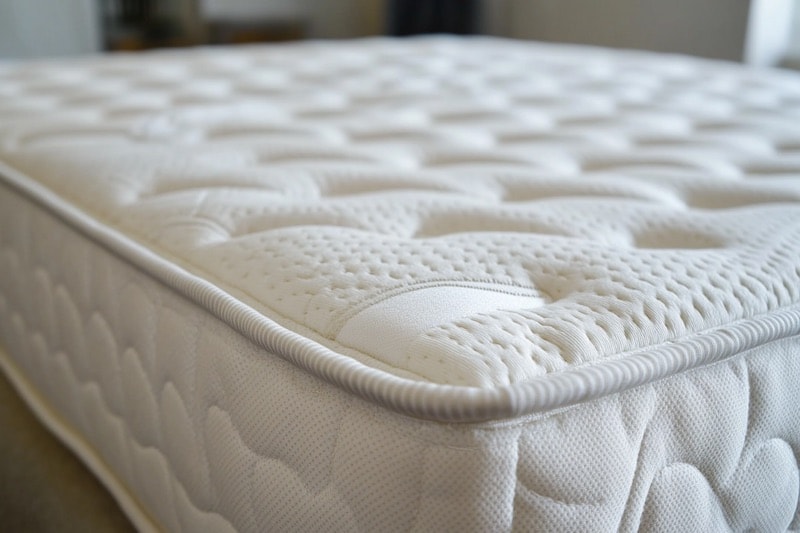
Key Takeaways:
-
Most Conventional Mattresses Contain Hidden Toxins—from VOCs and flame retardants to heavy metals and PFAS.
-
Health Risks Include respiratory irritation, skin sensitivities, hormonal disruption, and even increased cancer risk with prolonged exposure.
-
Red Flags: Strong off-gassing smell, older (pre-2009) mattresses with PBDEs, and labels listing polyurethane foam, vinyl covers, or unregulated flame retardants.
-
Safer Options: Look for organic latex, cotton, or wool mattresses certified by GOTS, GOLS, OEKO-TEX, or CertiPUR-US.
-
Interim Solutions: Use organic mattress toppers, air purifiers with activated carbon, and frequent bedding wash routines if you can’t immediately replace your mattress.
Yes, toxins in mattresses are a legitimate concern—it’s unsettling to think that where we rest each night could harbor flame retardants, plasticizers, or synthetic off-gassing chemicals. But by staying informed and making small, intentional changes (like adding an organic topper or switching to non-toxic sheets), you can significantly reduce your exposure and wake up feeling more refreshed and confident about your health.
If you’re shopping for a new mattress, research certified non-toxic models that rely on safe, natural materials.

FAQ to Toxins in Mattresses
Is mattress off-gassing harmful?
Mattress off-gassing can cause irritation in sensitive individuals, including headaches, dizziness, and respiratory issues. Although VOCs typically dissipate within days, prolonged exposure might exacerbate conditions like asthma. Ventilation for at least 24 hours is recommended to minimize the risks.
Are there harmful chemicals in mattresses?
Yes, many conventional mattresses contain harmful chemicals such as VOCs, flame retardants (e.g., PBDEs, organophosphates), PFAS, and heavy metals. These substances can lead to health issues ranging from respiratory irritation to hormonal disruption.
What are the symptoms of mattress poisoning?
Symptoms of exposure to toxic mattress chemicals include respiratory issues, allergic reactions, skin sensitivities, headaches, and hormonal imbalances. Prolonged exposure may also increase cancer risk and suppress immune function.
Do all mattresses have PFAS?
No, not all mattresses contain PFAS. However, some stain-resistant or water-repellent mattresses may include these "forever chemicals."
How long do mattresses emit VOCs?
Mattresses can emit VOCs for weeks or even months after purchase, though the strongest off-gassing typically subsides within the first few days. Low-level emissions may persist longer, especially in poorly ventilated spaces
Can a bad mattress cause health issues?
Yes, a bad mattress can cause health issues. Older mattresses may contain banned chemicals like PBDEs, while newer ones might still use VOC-emitting foams or PFAS. Symptoms can range from mild irritations to severe health problems over time. Choosing non-toxic materials and certifications like GOTS or GOLS can mitigate these risks













